With inflation running at its highest level in four decades, consumers are pinching their pennies and looking to dollar stores to stretch tightening budgets.
With inflation currently running at 7.5%, consumers are getting nervous about the economy. The February consumer sentiment survey issued by the University of Michigan noted households earning at least $100,000 were perhaps the most pessimistic.
“Shoppers finding inflation increases are more willing to figure out ways to save money. They might decide to shop more at these dollar stores, only shop when there’s a discount/coupon available, or find cheaper brands,” Anthony Martin, founder and CEO of Choice Mutual, told The Food Institute.
“Going to stores with lower quality products means shoppers save money when they spend it wisely. It can allow some families to get more food when other store prices exceed what they can reasonably afford or help them save more money for emergency funds and retirement.”
There’s little doubt consumers’ appetite for cheaper goods is strong.
Dollar General announced Friday it would add 1,100 U.S. locations in its fiscal 2022, creating 10,000 jobs. Earlier, Dollar Tree said in releasing its fourth quarter earnings it plans to open 400 Family Dollar and 190 Dollar Tree locations this year now that it has converted its price point to $1.25.
The COVID-19 pandemic gave Family Dollar, Dollar General, Five Below, Big Lots and Dollar Tree a boost, increasing food traffic by as much as 34.1%, taking a bite out of discount giant Walmart, analytics firm Placer.ai reported (Feb. 28).
“There are a few elements that create a draw for these locations. The orientation towards value is obviously a major selling point, especially for their core audience,” Ethan Chernofsky, vice president of marketing at Placer.ai, told The Food Institute. “In addition, the ability to get a lot done with a single shopping trip is a significant draw, enabling customers to accomplish more with each visit. The increasingly expansive product mix alongside the core value orientation creates a pull for a wide range of visitors.”
Ann Martin of CreditDonkey noted Walmart isn’t the only discount retailer feeling the pinch. She said Aldi also is affected, along with higher-priced alternatives like Target and Whole Foods.
“Dollar stores are popular because of their convenience – they are very easy to get in and out of for most customers – and offer great value on similar products to what you can find at mass retailers,” said Carlos Castelán, managing director of The Navio Group.
“We have not seen dollar stores compete directly with retail food outlets since most dollar stores do not offer fresh products – produce, meats, etc. – which is the foundation for most grocery trips. Retailers focused on winning back customers who may have gone to dollar stores can focus on smaller pack sizes or quantities to lower prices while continuing to expand convenience offerings like curbside pickup or buy-online/pickup in-store, which allow customers to fill in around larger stock up trips.”












